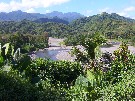

Kromanti
 The Maroons of Moore Town, located in the Blue Mountains and John Crow Mountains of Eastern Jamaica, are descendants of communities of former runaway African slaves who fled the sugar plantations of Jamaica from the 17th century onwards. Within this isolated community, at least one West African language, Kromanti, survived. Kromanti is an Akan language closely related to languages of the Akan dialect/language cluster, notably Twi and Fante, important languages in modern day Ghana.
The Maroons of Moore Town, located in the Blue Mountains and John Crow Mountains of Eastern Jamaica, are descendants of communities of former runaway African slaves who fled the sugar plantations of Jamaica from the 17th century onwards. Within this isolated community, at least one West African language, Kromanti, survived. Kromanti is an Akan language closely related to languages of the Akan dialect/language cluster, notably Twi and Fante, important languages in modern day Ghana.
According to reports, Kromanti survived as a language of normal everyday communication amongst the Maroons up until the early decades of the 20th century. Since then, its use has receded and it is known mainly by elderly members of the community. It is mainly restricted to religious and ceremonial life of the community.
A critical feature of Maroon heritage is the Kromanti language, used in a ritual ceremony known as Kromanti Play. This is a ceremony used to invoke ancestral spirits, involving dances, songs and special styles of drumming, in which the language is used to address the ancestors. Kromanti Play, inclusive of the linguistic aspects, is the easily the most distinctive feature which marks off the Maroons of Moore Town from non-Maroon Jamaicans. However, its survival is under threat. Because of traditions of secrecy, fewer and fewer of the young Maroons have much knowledge of the language and as a consequence the accompanying cultural heritage associated with it.
It is against this background that UNESCO, in 2003, named the Maroon Heritage of Moore Town (Jamaica), as one of the Masterpieces of the Oral and Intangible Heritage of Humanity.
Classification: Akan (Twi-Asante)
Population: Ritual language used by no more than a few dozen elderly people
Region: Moore Town, Portland, Jamaica.
More on Kromanti:
1. Article on Kromanti, by Hubert Devonish
2. Links related to Kromanti


